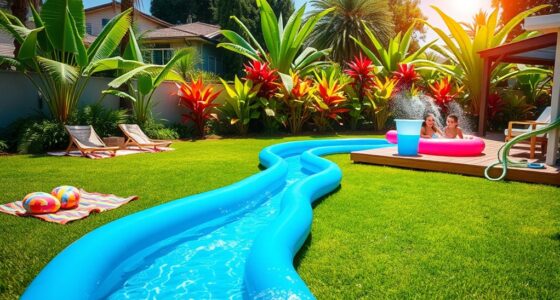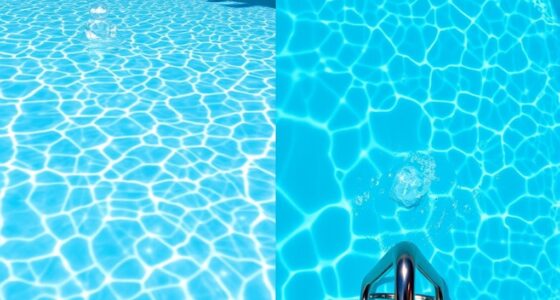Swimmable ponds are a natural choice for backyard swimming that combines beauty and eco-friendliness. You’ll enjoy crystal-clear waters without harsh chemicals like chlorine, thanks to biological filters such as aquatic plants and beneficial bacteria. These ponds support local wildlife and maintain ecological balance, creating a sustainable, self-cleaning environment. If you want to learn how to design, maintain, and benefit from these natural pools, there’s much more to discover.
Key Takeaways
- Swimmable ponds are eco-friendly, chemical-free alternatives to traditional pools, providing a natural swimming environment.
- They use biological filtration methods like aquatic plants and biofalls to maintain water clarity and quality.
- Ecological balance, involving plants, fish, and beneficial bacteria, is essential for water health and algae control.
- Proper design and regular maintenance ensure the pond remains clean, clear, and inviting for swimming.
- These natural ponds support biodiversity and offer a sustainable, aesthetically pleasing backyard swimming option.

Have you ever wondered if it’s possible to enjoy a natural, crystal-clear pond right in your backyard? Swimmable ponds are gaining popularity as an eco-friendly alternative to traditional pools, offering a more natural and sustainable way to cool off and relax. The key to creating a pond that’s inviting, safe, and visually appealing lies in effective water filtration and maintaining ecological balance. These elements work together to keep the water clean without relying on harsh chemicals, ensuring you get a pristine swimming experience while supporting local wildlife.
Water filtration in swimmable ponds isn’t just about removing debris; it’s about creating a balanced environment that encourages beneficial bacteria and natural processes to thrive. Many natural pond systems incorporate biological filters—such as aquatic plants and biofalls—that break down organic matter and absorb nutrients that could otherwise lead to algae blooms. When you build a pond with proper water filtration, you reduce the need for chlorination or chemical treatments, which can harm both swimmers and the ecosystem. Instead, your pond becomes a self-sustaining system where water stays clear and healthy through natural filtration methods.
Proper water filtration creates a balanced, natural environment that keeps your pond clear and healthy without chemicals.
Maintaining ecological balance is essential for ensuring your pond remains swimmable over the long term. This involves carefully selecting the right plants and aquatic life to promote a balanced ecosystem. For instance, submerged plants help oxygenate the water and absorb excess nutrients, while floating plants provide shade and reduce algae growth. Fish and beneficial bacteria also play critical roles in controlling organic waste and maintaining water clarity. When these elements are in harmony, they create a stable environment where the water stays clean without constant intervention. This balance not only enhances water quality but also encourages local wildlife to thrive, making your pond a vibrant part of your backyard ecosystem.
Designing a swimmable pond with water filtration and ecological balance in mind means you’re creating a natural oasis that’s both beautiful and functional. Regular maintenance, like monitoring water levels and trimming overgrown plants, helps sustain this delicate balance. You’ll find that with proper planning, your pond can stay crystal-clear and inviting for swimming, all while supporting a healthy ecological system. This approach offers a revitalizing alternative to conventional pools, combining the benefits of nature with the enjoyment of swimming in clean, chemical-free water. Ultimately, a carefully balanced swimmable pond becomes a serene retreat—one that’s as environmentally responsible as it is enjoyable.
Frequently Asked Questions
How Much Maintenance Do Swimmable Ponds Require Annually?
You’ll need to dedicate some time each year to maintain your pond, mainly focusing on pond filtration and algae control. Regularly check and clean the filtration system to keep water clear and healthy. You should also monitor algae growth and use natural treatments if needed. Overall, with consistent effort, annual maintenance becomes manageable, ensuring your swimmable pond stays inviting and eco-friendly without requiring extensive work.
Are Swimmable Ponds Suitable for All Climate Zones?
Wondering if swimmable ponds suit every climate zone? Well, they’re as adaptable as a chameleon in a box of crayons! Climate adaptability varies, so regional suitability depends on your area’s temperature and rainfall. If you live in a drastic climate, you might need extra planning or maintenance. But if your region’s moderate, these natural swimming spots can be a perfect fit. Just check local conditions, and plunge into it!
What Is the Average Cost of Installing a Natural Pool?
You’re wondering about the average cost of installing a natural pool. The cost estimation varies depending on size, design, and location, but generally, you should consider your budget considerations carefully. On average, natural pools can range from $20,000 to $50,000 or more. It is crucial to do thorough research and get multiple quotes to make informed decisions, ensuring your investment aligns with your financial plans and desired features.
Can Swimmable Ponds Support Diverse Aquatic Life?
Imagine a vibrant underwater city where aquatic life thrives. Swimmable ponds support diverse aquatic biodiversity by creating a balanced ecosystem. You provide a safe habitat, encouraging fish, plants, and insects to coexist harmoniously. With proper design, these ponds sustain ecosystem balance, turning your backyard into a lively, natural sanctuary. Yes, they can support a rich variety of aquatic species, making your pond a thriving hub of life.
How Long Does It Take to Establish a Fully Functional Natural Pool?
Establishing a fully functional natural pool typically takes about 3 to 6 months. During this time, you focus on achieving biological balance through consistent maintenance and encouraging plant establishment. As plants grow and the ecosystem stabilizes, the pool naturally filters and clarifies the water. Patience is key—monitor water quality regularly, add plants as needed, and avoid chemical treatments to support a healthy, sustainable aquatic environment.
Conclusion
Imagine relaxing in your backyard pond, crystal-clear and teeming with aquatic life, just like the innovative natural pools in Germany that blend seamlessly with nature. Swimmable ponds offer a sustainable, chemical-free alternative to traditional pools, transforming your outdoor space into a tranquil oasis. With proper design and maintenance, you can enjoy safe, invigorating swims whenever you desire—no chemicals needed. Embrace this eco-friendly choice and turn your yard into a personal paradise.









